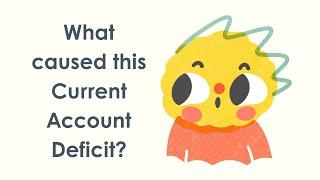
What’s up with India’s Current Account Deficit?
🌐 Understanding India's Rising Current Account Deficit 🌐
In this informative video, we delve into the intricacies of India's current account deficit and what led to its recent surge. Join us as we break down this complex economic concept into simple terms and explore its implications for India's economy.
📈 Key Points Covered 📉
Definition of Current Account Deficit and its role in a country's Balance of Payments.
Analogies to a lemonade stand to illustrate import-export dynamics.
Factors contributing to India's current account deficit increase, including trade deficits, service exports, and private transfer receipts.
The economic consequences of a persistent deficit, including potential borrowing and its impact on the economy.
Strategies to narrow the deficit, such as boosting exports, reducing imports, and focusing on export competitiveness.
🌱 What Can India Do? 🌱
Discover actionable steps India can take to address its current account deficit and work towards a more balanced economic landscape.
🌍 Global Economic Insights 🌍
Gain a broader perspective on how international trade and financial flows impact economies worldwide.
📊 Learn More 📊
Balance of Payments (BoP):
The Balance of Payments is a comprehensive accounting record of all economic transactions conducted between residents of one country and the rest of the world over a specific period, typically a year or a quarter. It consists of two main components: the Current Account and the Capital Account. The BoP provides insights into a country's international financial position, showing how much money flows into and out of the country due to trade, investments, and other financial activities.
Current Account:
The Current Account is one of the two primary components of a country's Balance of Payments. It records all transactions related to the import and export of goods and services, income earned from foreign investments, and unilateral transfers (such as foreign aid or remittances). A surplus in the Current Account indicates that a country is earning more from its international activities than it is spending, while a deficit means it is spending more than it is earning.
Capital Account:
The Capital Account is the other main component of a country's Balance of Payments. It tracks international financial flows related to capital transactions, including foreign investments, loans, and other financial assets. It reflects changes in a country's foreign financial assets and liabilities. A surplus in the Capital Account typically means that a country is receiving more foreign investment than it is investing abroad, while a deficit suggests the opposite.
Inflation:
Inflation refers to the sustained increase in the general price level of goods and services in an economy over time. It indicates a decrease in the purchasing power of a country's currency, as each unit of currency buys fewer goods and services. Inflation can erode the real value of money, impact savings, and affect the overall cost of living. Central banks often aim to manage inflation within a target range to maintain price stability and economic growth.
Currency Depreciation:
Currency depreciation occurs when a country's currency loses value in comparison to other currencies on the foreign exchange market. It means that the exchange rate for the depreciating currency increases, and it takes more of that currency to purchase the same amount of foreign currency. Currency depreciation can result from various factors, including trade imbalances, economic instability, changes in interest rates, or market sentiment. It can have both positive and negative effects on a country's economy, impacting trade competitiveness and the cost of imported goods.
Thank you for tuning in! If you're curious about the economic intricacies that drive nations, be sure to like, subscribe, and share this video with your friends. Stay informed, stay curious!
#EconomicAnalysis #CurrentAccountDeficit #BalanceOfPayments #TradeDeficit #IndianEconomy #ExportImport #FinancialEducation #EconomicImpact #InvestmentStrategies #FinancialLiteracy #GlobalEconomy #EconomicOutlook #PolicyReforms #TradePolicy
#EconomicGrowth #IndiaTrade #EconomicTrends #FinancialPlanning
#ExportCompetitiveness #ImportReduction
In this informative video, we delve into the intricacies of India's current account deficit and what led to its recent surge. Join us as we break down this complex economic concept into simple terms and explore its implications for India's economy.
📈 Key Points Covered 📉
Definition of Current Account Deficit and its role in a country's Balance of Payments.
Analogies to a lemonade stand to illustrate import-export dynamics.
Factors contributing to India's current account deficit increase, including trade deficits, service exports, and private transfer receipts.
The economic consequences of a persistent deficit, including potential borrowing and its impact on the economy.
Strategies to narrow the deficit, such as boosting exports, reducing imports, and focusing on export competitiveness.
🌱 What Can India Do? 🌱
Discover actionable steps India can take to address its current account deficit and work towards a more balanced economic landscape.
🌍 Global Economic Insights 🌍
Gain a broader perspective on how international trade and financial flows impact economies worldwide.
📊 Learn More 📊
Balance of Payments (BoP):
The Balance of Payments is a comprehensive accounting record of all economic transactions conducted between residents of one country and the rest of the world over a specific period, typically a year or a quarter. It consists of two main components: the Current Account and the Capital Account. The BoP provides insights into a country's international financial position, showing how much money flows into and out of the country due to trade, investments, and other financial activities.
Current Account:
The Current Account is one of the two primary components of a country's Balance of Payments. It records all transactions related to the import and export of goods and services, income earned from foreign investments, and unilateral transfers (such as foreign aid or remittances). A surplus in the Current Account indicates that a country is earning more from its international activities than it is spending, while a deficit means it is spending more than it is earning.
Capital Account:
The Capital Account is the other main component of a country's Balance of Payments. It tracks international financial flows related to capital transactions, including foreign investments, loans, and other financial assets. It reflects changes in a country's foreign financial assets and liabilities. A surplus in the Capital Account typically means that a country is receiving more foreign investment than it is investing abroad, while a deficit suggests the opposite.
Inflation:
Inflation refers to the sustained increase in the general price level of goods and services in an economy over time. It indicates a decrease in the purchasing power of a country's currency, as each unit of currency buys fewer goods and services. Inflation can erode the real value of money, impact savings, and affect the overall cost of living. Central banks often aim to manage inflation within a target range to maintain price stability and economic growth.
Currency Depreciation:
Currency depreciation occurs when a country's currency loses value in comparison to other currencies on the foreign exchange market. It means that the exchange rate for the depreciating currency increases, and it takes more of that currency to purchase the same amount of foreign currency. Currency depreciation can result from various factors, including trade imbalances, economic instability, changes in interest rates, or market sentiment. It can have both positive and negative effects on a country's economy, impacting trade competitiveness and the cost of imported goods.
Thank you for tuning in! If you're curious about the economic intricacies that drive nations, be sure to like, subscribe, and share this video with your friends. Stay informed, stay curious!
#EconomicAnalysis #CurrentAccountDeficit #BalanceOfPayments #TradeDeficit #IndianEconomy #ExportImport #FinancialEducation #EconomicImpact #InvestmentStrategies #FinancialLiteracy #GlobalEconomy #EconomicOutlook #PolicyReforms #TradePolicy
#EconomicGrowth #IndiaTrade #EconomicTrends #FinancialPlanning
#ExportCompetitiveness #ImportReduction
Комментарии:
HUMPBACK WHALES SINGING in their natural habitat - video
Два Банана - Экскурсии в Доминикане
Xiaomi Mi Band 3 on iPhone Review | Banggood
Nabeel Nawab
Rescue the Republic. Unify.
Bret Weinstein
Бейжің Олимпиадасы. Конькимен жүгіру. Надежда Морозова
Qazaqstan TV / Қазақстан Ұлттық Арнасы
DILATED PORES OF WINER!
Dr. Mudgil
ТОП ГОИНГ ДИП с КАМНЯ в РАСТ/RUST
baduplay


























